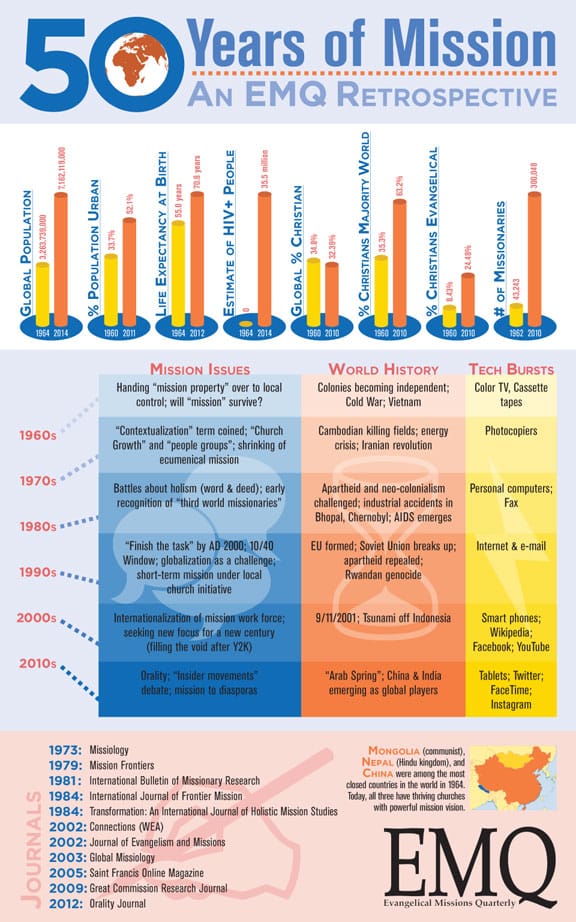ANNIVERSARY COLLECTION: Missiographic: 50 Years of EMQ: A Decade by Decade Overview

by Stan Nussbaum and James Nelson
Just how versatile is the gospel? Does it have to change in order to stay ‘the same’ in a new context?
1964-1974 | Separating Mission from Colonialism
As most remaining colonies were becoming independent countries, missionaries were handing mission property and church governance over to local control. They were also breaking old habits of cultural colonialism and taking a more appreciative look at local cultures. Raymond Buker (“The Missionary and Culture,” October 1964) pointed to the ambiguous relationship between gospel and culture: “Although the Gospel does not change, it is very versatile.” Fifty years later, we are still working to fully unpack that statement.
1974-1984 | Affirming Mission in a Post-colonial Era
Did mission die out with the colonial era? Some in the ecumenical mission world were saying “yes” to this question. In 1974, the ten-day Lausanne Congress gave a thundering “no.” Under the leadership of John Stott and Billy Graham, the Congress of 2,430 delegates produced the Lausanne Covenant and launched the Lausanne Committee for World Evangelization. Expanding on his “E-3” evangelism concept (January 1974), Ralph Winter called for a major shift in mission conceptualization from nation states to people groups. The October 1974 EMQ reflected on the Lausanne event and its call to mission action. Mission was affirmed as a biblical mandate and therefore a continuing responsibility for the Church until Christ’s return.
1984-1994 | Increasing Attention to “Unreached Peoples,” Cities, Muslims, and Holism/Justice
Work done in the previous decade on defining post-colonial mission was expanded in several directions. Jim Reapsome wrote, “In the last decade what might be called the ‘unreached people groups’ strategy has shaken the missions community to the core” (January 1984). But he took an EMQ approach to it, thoroughly assessing its pros and cons rather than jumping on the bandwagon. Harvie Conn (October 1984) called for attention to burgeoning cities, moaning that “…the evangelical church finds itself hampered by an anti-urban bias fed by mythologies of the past” when mission work meant rural work. Articles by Greg Livingston (July 1986) and Phil Parshall (July 1985) raised the profile of missions among Muslims. Jon Bonk (October 1984) raised the issue of missionary affluence and lifestyle, citing a list of recent books on this theme. All these discussions continue to the present, particularly the one on holism.
1994-2004 | Internationalizing Mission Agencies
Already in April 1984 in an interview about EMQ’s first twenty years, Wade Coggins had identified “the rise of mission agencies and missionaries in Africa, Asia, and Latin America” as the most significant change in mission since 1964. In the October 1994 EMQ, Vinoth Ranachandra pled for Western workers to be “accountable primarily to the national church leaders,” and Brad Walz highlighted the need to develop a sending vision among national churches. David Zac Niringiye (January 1995) sketched the prospects for Africa, many of which were realities by the end of the decade. Partnership was constantly discussed and queried from all angles (e.g., “Western-National Church Partnerships: Are They Really a Good Idea?” October 2004).
2004-2014 | Contextualizing Mission and Church
Having “kicked off public debate on how far contextualization has gone, is going and will probably continue to go” in a 1998 issue featuring John Travis’ “C1 to C6 Spectrum,” EMQ revisited the topic in its July 2004 issue. Parshall wrote about seven touch point issues, including how “Son of God” would be translated—a centerpiece of the insider-movement debates to come. Contextualization was the hottest issue of the decade, not least because it raised the question of what “theology” is and whether a Western approach to theology is the same thing as a biblical approach. Colin Andrews suggested, “We need to move away from theology and toward theologies” (“Contextualization in a Glocalizing World,” January 2009). This takes us full circle to 1964 asking, Just how versatile is the gospel? Does it have to change in order to stay ‘the same’ in a new context?
….
CREDIT: Infographic by www.missiographics.com, a service of Global Mapping International (GMI).
Stan Nussbaum is staff missiologist for GMI Research Services since 1993 and author of A Reader’s Guide to Transforming Mission Orbis). He has field experience in Lesotho and England. James Nelson (pseudonym) is vice president of research with GMI, senior research associate for Fruitful Practice Research, and mission research consultant for Missio Nexus. Author of Crossing Cultures with Ruth (GMI 2014), James has served as a fieldworker and business creator in Southeast Asia.
EMQ, Vol. 50, No. 4, pp. 414-416. Copyright © 2014 Billy Graham Center. All rights reserved. Not to be reproduced or copied in any form without written permission from EMQ editors.

